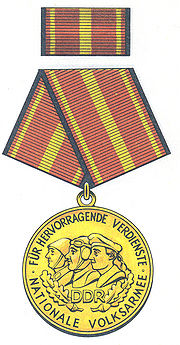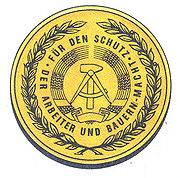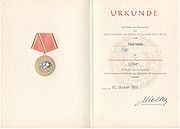
Medal of Merit of the National People's Army
Encyclopedia

Established on June 1, 1956 in three levels, Gold, Silver and Bronze. It was awarded for outstanding merit and personal readiness in support of the increase of combat capability and combat readiness of the National People's Army
National People's Army
The National People’s Army were the armed forces of the German Democratic Republic .The NVA was established in 1956 and disestablished in 1990. There were frequent reports of East German advisors with Communist African countries during the Cold War...
.
Awarded in the name of the Minister for National Defense it was presented on the "National People's Army Day", 1 March, on the Day of the Republic, 7 October, or immediately after the achievement.
Award criteria
The medal was presented to:- Members of the -
- Landstreitkräfte (Army)
- Volksmarine (Navy)
- Luftstreitkräfte (Air Forces)
- Ministerium für Staatssicherheit (MfS / Ministry for State Security), commonly known as the StasiStasiThe Ministry for State Security The Ministry for State Security The Ministry for State Security (German: Ministerium für Staatssicherheit (MfS), commonly known as the Stasi (abbreviation , literally State Security), was the official state security service of East Germany. The MfS was headquartered...
(including Stasi agents and informers)
- Individuals in civil serviceCivil serviceThe term civil service has two distinct meanings:* A branch of governmental service in which individuals are employed on the basis of professional merit as proven by competitive examinations....
- Individuals employed by the National People's Army
- Individuals who are not members of the National People's Army
- Collectives with membership of any of the previously mentioned groups
By regulation all three levels could be awarded to any rank in the armed forces. But in practice, the gold medal was usually reserved to field grade and general officers, while the silver and bronze grades were more commonly awarded to noncomissioned officers (NCOs) and company grade officers.
An individual of any rank who had earned the Best Soldier badge for seven consecutive years was eligible for the bronze medal, for nine years the silver medal and twelve years the gold medal.
Medal description
The medal was designed by the BerlinBerlin
Berlin is the capital city of Germany and is one of the 16 states of Germany. With a population of 3.45 million people, Berlin is Germany's largest city. It is the second most populous city proper and the seventh most populous urban area in the European Union...
graphic artist Paul Gensch. It is round and either bronze colored (Bronze), silvered (Silver) or gilded (Gold) and has a diameter of 35 mm (1.4 inches). On the front are profiles of the busts of a 1950s era sailor
Sailor
A sailor, mariner, or seaman is a person who navigates water-borne vessels or assists in their operation, maintenance, or service. The term can apply to professional mariners, military personnel, and recreational sailors as well as a plethora of other uses...
, airman
Airman
An airman is a member of the air component of a nation's armed service. In the United States Air Force and the Royal Air Force , it can also refer to a specific enlisted rank...
, and soldier
Soldier
A soldier is a member of the land component of national armed forces; whereas a soldier hired for service in a foreign army would be termed a mercenary...
representing the nation's Land, Air, and Naval forces, under which is spelled out "DDR". On each side of this are three oakleaves with an acorn. The words FÜR HERVORRAGENDE VERDIENSTE (FOR OUTSTANDING MERIT) form the upper part of the medal, the lower part contain the words NATIONALE VOLKSARMEE (NATIONAL PEOPLE'S ARMY).

Laurel wreath
A laurel wreath is a circular wreath made of interlocking branches and leaves of the bay laurel , an aromatic broadleaf evergreen. In Greek mythology, Apollo is represented wearing a laurel wreath on his head...
.
The medal is suspended from a five sided cloth ribbon which is 48 mm (1.9 inches) at the widest point. The ribbon is red with black narrow edge stripes and a narrow yellow stripe 1 mm (1/32 inch) from the black edge stripe. The Silver medal is suspended from the same basic ribbon but has the addition of a 3 mm (just over 3/32 inch) wide center stripe of silver/white. On the Gold medal ribbon the center stripe is gold/yellow.
The ribbon bar is 24 mm (just under 1 inch) wide, rectangular and corresponds with the medal ribbon.
The medal was awarded with a certificate and financial allowance and was worn on the left upper chest.

Medal variations
Several distinct variations of each grade of this medal exist. According to research by John Standberg the different types are:Gold
- 1st Type (1956-57) - 900 Silver, gold plated, content stamp on rim at 6 o'clock, serial numbered at 12 o'clock on reverse. Obverse has dots separating inscriptions
- 2nd Type (1958-59) Same as Type 1, without dots
- 3rd Type (1959-60) Same as Type 2, without serial number
- 4th Type (1960-72) 900 Silver, gold plated, content stamp below the branches on the reverse at 6 o'clock, no serial number Obverse has dots.
- 5th Type (1973-76) Same as Type 4, bronze, gold plated.
- 6th Type (1975) Same as Type 4, “9” in content stamp is distinctly different.
- 7th Type (1977-83) Same as Type 5, with “-UND-“, 34.7 mm in diameter
- 8th Type (1983-86) Same as Type 7,35 mm in diameter
- 9th Type (1986-90) Same as Type 8, grain stalks in the NV A emblem are stylized and closed
Silver
- 1st Type (1956-57) 900 Silver, gold plated, content stamp on rim at 6 o'clock, serial numbered at 12 o'clock on reverse. Obverse has dots separating inscriptions
- 2nd Type (1958-59) Same as Type 1, without dots
- 3rd Type (1959-60) Same as Type 2, without serial number
- 4th Type (1960-73) 900 Silver, gold plated, content stamp below the branches on the reverse at 6 o'clock, no serial number Obverse has dots.
- 5th Type (1973-76) Same as Type 4, bronze, gold plated.
- 6th Type (1975) Same as Type 4, "9" in content stamp is distinctly different.
- 7th Type (1977-83) Same as Type 5, with 11 -UND-", 34.7 mm in diameter
- 8th Type (1983-86) Same as Type 7, 35 mrn in diameter
- 9th Type (1986-90) Same as Type 8, grain stalks in the NVA emblem are stylized and closed
Bronze
- 1st Type (1956-57) Serial numbered at 12 o’clock on reverse. Obverse has dots separating inscription.
- 2nd Type (1958-59) Same as Type 1, without dots.
- 3rd Type (1959-60) Same as Type 2, without serial number
- 4th Type (1960-76) Same as Type 1, without serial number
- 5th Type (1977-83) Same as Type 4, with “-UND-“, 34.7 mm
- 6th Type (1983-86) Same as Type 5, 35 mm in diameter
- 7th Type (1986-90) Same as Type 6, grain stalks in the NVA emblem are stylized and closed
Well known recipients
Gold - Karl-Eduard von SchnitzlerKarl-Eduard von Schnitzler
Karl-Eduard von Schnitzler was an East German journalist, propagandist, and host of the television show Der schwarze Kanal from March 21, 1960 to October 30, 1989....
famous for his reporting for Der schwarze Kanal
Der schwarze Kanal
Der schwarze Kanal was a series of political propaganda programmes broadcast weekly between 1960 and 1989 by East German television. Each edition was made up of recorded extracts from recent West German television programmes re-edited to include a Communist commentary.The programme was hosted by...
.
Bronze - Vladimir Putin
Vladimir Putin
Vladimir Vladimirovich Putin served as the second President of the Russian Federation and is the current Prime Minister of Russia, as well as chairman of United Russia and Chairman of the Council of Ministers of the Union of Russia and Belarus. He became acting President on 31 December 1999, when...
awarded in 1988 by Stasi
Stasi
The Ministry for State Security The Ministry for State Security The Ministry for State Security (German: Ministerium für Staatssicherheit (MfS), commonly known as the Stasi (abbreviation , literally State Security), was the official state security service of East Germany. The MfS was headquartered...
chief Erich Mielke
Erich Mielke
Erich Fritz Emil Mielke was a German communist politician and Minister of State Security—and as such head of the Stasi —of the German Democratic Republic between 1957 and 1989. Mielke spent more than a decade as an operative of the NKVD during the rule of Joseph Stalin...
for his service as a KGB
KGB
The KGB was the commonly used acronym for the . It was the national security agency of the Soviet Union from 1954 until 1991, and was the premier internal security, intelligence, and secret police organization during that time.The State Security Agency of the Republic of Belarus currently uses the...
agent in Dresden
Dresden
Dresden is the capital city of the Free State of Saxony in Germany. It is situated in a valley on the River Elbe, near the Czech border. The Dresden conurbation is part of the Saxon Triangle metropolitan area....
and Leipzig
Leipzig
Leipzig Leipzig has always been a trade city, situated during the time of the Holy Roman Empire at the intersection of the Via Regia and Via Imperii, two important trade routes. At one time, Leipzig was one of the major European centres of learning and culture in fields such as music and publishing...
.

